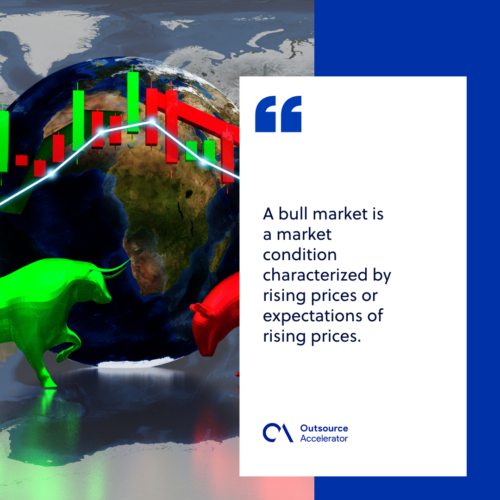Bull market
Definition
What is a bull market?
A bull market is a market condition characterized by rising prices or expectations of rising prices. While a bull market typically refers to the stock market, the term can also apply to other traded resources such as bonds, commodities, real estate, and currencies.
Along with market prices, investor sentiments also soar during bull markets. Extended periods of increased stock prices[1] carry investors’ optimism, confidence, and high expectations. Conversely, investor confidence and optimism play a significant role in rising prices.
A 20% increase in stock prices following two consecutive declines of at least 20% is the commonly accepted threshold for a market to be considered bullish.
Due to the constant price fluctuation of securities while trading, markets are typically only dubbed as bull markets when large numbers of securities experience an increase in prices for an extended period.
Bull markets are so-called as the upward trend of market prices is likened to the upward movement of a bull’s horn as it attacks.
In contrast, a bearish market’s plunging prices are characterized by a bear’s downward swipes as it strikes.

What are the characteristics of a bull market?
Bull markets typically extend over months or even years. The bullish trend tends to happen as an economy gains strength or is already strong.
The increase usually coincides with a strong gross domestic product (GDP), a decrease in unemployment[2], and rising corporate profits.
Stocks demand, as well as the general market tone, will be positive during bull markets. Bullish trends also promote more initial public offering (IPO) activities.
Unlike in bear markets, bullish trends are hard to predict, and investors generally only identify bull markets retrospectively.
What to do during a bull market
Investors looking to profit off bull markets will want to make early buys to make the best of rising prices and sell them for maximum profit.
There are several strategies that investors use during bullish market trends. However, the difficulty in assessing current market states means that these strategies carry a certain degree of risk.
Retracement additions
Retracements — temporary reversals within the current market trend — are utilized by some investors as a signal to buy.
During retracements, a given stock’s prices drop. Investors take advantage of the stock’s price decrease and make purchases.
Buying stocks during retracement periods effectively gives investors a discounted price, provided that the overarching upward market trend continues.
Buy-and-hold
Buying and holding stocks is one of the most basic strategies in investing. As the name suggests, the strategy involves purchasing stocks and holding onto them to sell at a later, more profitable date.
Using this strategy naturally entails risk and requires confidence from the investor as there is no guarantee that the stock’s price will increase.
Increased buy-and-hold
The increased buy-and-hold strategy builds up from the more rudimentary version of this strategy and carries additional risks. In this variation, an investor would continually increase their holdings in a given stock as long as its price continues to rise.
A common method of adding to existing holdings is by purchasing a fixed quantity of additional shares every time the prices of a stock increase by a set amount.
Full-swing trading
In full-swing trading, investors actively invest and capitalize on a market’s bullish trend. They use various trading techniques such as short-selling to make the most profits from the bull market.
Article references:
[1] Stock prices: McDonald, J. G., & Fisher, A. K. (1972). New-Issue Stock Price Behavior. The Journal of Finance, 27(1), 97–102. https://doi.org/10.2307/2978508
[2] Unemployment: Jahoda,Marie, 1982. “Employment and Unemployment,” Cambridge Books, Cambridge University Press, number 9780521285865, June.







 Independent
Independent




